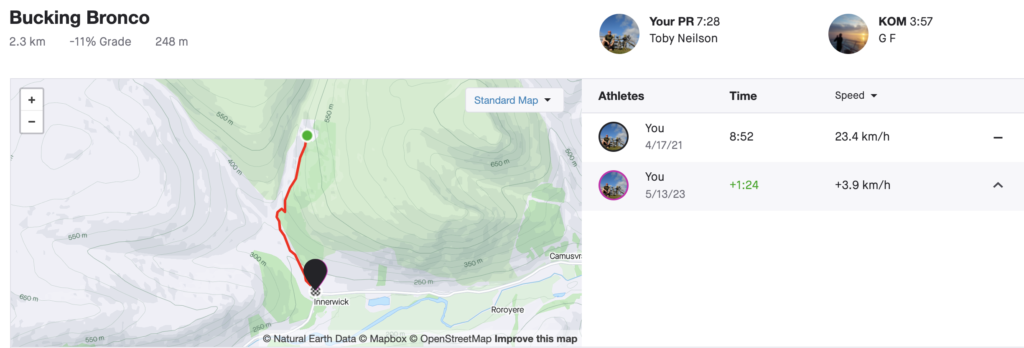Gimmick or Game Changer?
The very mention of a suspension stem is likely to raise the hackles of many bike riders. Abandoned, and derided, MTB tech of the 90s put the notion of a suspension stem very much on the backburner as dedicated suspension forks became the norm in the mountain bike world. However, the year is now 2023 and gravel cycling has seen a huge surge in popularity over the last few years, according to the NY Times seeing a 109% surge in sales from 2019 to 2021.
In this context, Redshift have to my mind positioned themselves superbly as a brand that offers a series of products aimed at those looking to add some comfort and versatility to their gravel bikes. Their Shockstop Suspension Stem is at the apex of this. Gone are the clunky and weighty mechanics of suspension stems of old, and here we have an option very much pitched at the adventure cycling market of the 21st century.

While perhaps most keenly aimed at gravel cyclists, I can see this being of use to road cyclists and commuters in turn – particularly on the pothole ridden lanes we have to contend with here in the UK. This innovative stem aims to revolutionise the way we think about ride comfort and bike control, but does it accomplish this?
I will provide more detail below, but since installing my suspension stem I have noticed a tangible improvement in comfort, confidence and (to my surprise) speed on my gravel rides. While the stem certainly comes with a weight cost compared to a traditional stem, the vibration damping it provides on gravel trails and dirt tracks has legitimately made me a faster rider. As such, for me, this is no gimmick – and has indeed been a game changer.
Take a look for me full rundown below. Note: this review is based on the standard shockstop stem, not their more expensive Pro version. From what I can see, the pro version comes in at an extra £60 price premium simply for being 15% lighter. I am no weight weeine, so this doesn’t feel like a justifiable tradeoff – but it may to others.
How does Redshift’s suspension stem work?
At first glance, the Redshift Suspension Stem looks like a typical high-quality stem. It’s only upon closer inspection that its unique design features become apparent. The stem is crafted from premium-grade aluminium, striking a balance between lightweight durability and robustness. The finish is sleek and fits well with most bike aesthetics, making it an attractive addition to any setup.
The heart of the stem is its suspension mechanism. Unlike traditional stems, it features a hidden elastomer system that allows for 20mm of vertical movement up and down. This design is engineered to absorb shocks and vibrations from uneven road surfaces, translating to a smoother ride. I was dubious as to the difference this could make, but the stem’s oscillation and bump-damping is significant enough to make a noticeable difference on rough trails but subtle enough not to affect the bike’s handling or responsiveness.
Installation and Compatibility
Installing the Redshift Suspension Stem is straightforward. It’s compatible with most handlebars and steerer tubes, making it a versatile option for a wide range of bikes. The only caveat is its weight, which is slightly higher than a standard stem. This might be a concern for weight-conscious road racers, but for the majority of riders, particularly those in the market for such a product, the added comfort outweighs the minimal weight gain.
I installed this on my gravel bike with almost no issues. There are helpful instructions included on which elastomers to choose based on your weight, I didn’t actually have to change mine around from what came preloaded as standard, but it looks a simple enough process. You can also dial in different degrees of vibration damping to attune to your own preferences. I personally prefer a slightly firmer feel – which means the stem feels totally rigid when I’m on the handlebars, until a bump or rough surface is encountered at which point it’s clear that the system is activating.
Redshift have a helpful video on installation here.

Performance – Faster Gravel Riding?
While so much of this is subjective and based on “ride feel”, there is no doubt in my mind that riding with this stem is more comfortable that riding without it. Long days in the saddle on gravel trails previously could be really draining on my forearms, now with the Redshift stem fitted my arms definitely feel fresher than they would have done previously. In terms of comfort, this absolutely performs. But what about speed?
While the weight penalty of this stem might put some riders off, I would venture that I ride faster on gravel rides with it on than with it off. Moreover, I highly doubt that I ride any slower on road rides with it on than off.
As a means of quantifying this with some data, the below Strava screengrab shows 2 different efforts on a particularly bumpy gravel descent from Rannoch into Glen Lyon, here in Highland Perthshire.

As you can see, my first attempt at this 2.3km -11% average gradient descent saw me get down it in 8:52. On my second attempt, conducted in similar Spring conditions, the only difference was that I had the suspension stem on my bike. I went down it one minute 24 seconds faster – this represents a 15% improvement in speed. I realise that this test isn’t perfect – perhaps I am a more confident descender, and now more familiar with this particular descent on my second crack at it. These imperfections in a scientific fair test aside, there is no doubt in my mind that the suspension stem is the key driver behind this improvement in speed.
What this test doesn’t represent is the sense of confidence I felt on this second attempt – gone were the sore arms, I was braking less and the results consequently speak for themselves. As such, I am confident to say that the Redshift ShockStop stem will make you ride faster, and make you more comfortable in the process. What’s not to like?
Is the Shockstop Stem Good Value for Money?
The “standard” version of Redshift’s suspension stem is priced at £189.99. Given that most rigid stems can be picked up for a mere £20-£50 depending on your weight preferences, this is undeniably a much pricier option than its traditional competition.
Given the 15% improvement in gravel descent speed I’ve logged above, I would wager that this however does represent excellent value for money from a performance perspective. I suspect people spend thousands of pounds on lighter or more aero wheels and would be thrilled with such a performance increase.
If we discount performance, and focus simply on the comfort this provides, I would also say that for me this does also represent good value. Gravel riding can be hard work, and this definitely takes out the sting from the gnarlier sections. Plus, it’s a good conversation piece!
As mentioned in my introduction, there is a “Pro” version available, it weighs 15% less than the standard stem yet costs over 30% more. For me, on paper the Pro version doesn’t represent the value for money that the standard stem does. If you’re extremely weight conscious and financially flush – then by all means go for it, but for me I would suggest just sticking with the cheaper iteration; it does the same job and basically weighs the same.
Conclusion
No surprises here if you’ve read any of the above, but I love this suspension stem. Before purchasing I wasn’t sure if I was just buying a gimmick, doomed to repeat the failed stem tech of the 90s. I am glad to report this was not the case – this is not a gimmick, it’s a game changer.
My rides are faster and conducted with more comfort. I imagine this would be a particularly attractive proposition if you’ve maxed out your available tyre clearance but looking to gain some more compliance and control for your rides – rather than spending huge sums on a new frame to widen your available tyre options, simply installing one of these stems will provide a great deal of the comfort and confidence synonymous with wider rubber.
Redshift Suspension Stem FAQs
- Is the Redshift Suspension Stem worth the money?
To our minds, yes – it’s absolutely worth the money. It’s made our off-road riding faster, and more comfortable. We even logged a 15% improvement in gravel descending speed. For £190, this seems great value for money compared to other bike upgrades, such as wheels.
- Does the Redshift Suspension Stem actually work?
Yes, it actually works very well. While on paper 20mm of travel may not sound like a lot, in practice this provides a really helpful amount of vibration damping on rough roads and trails.
- Is the suspension stem easy to install?
I personally did find this easy to install, and I am not a talented mechanic. There are a number of options available for fine tuning the resistance level of the stem with the elastomers provided with the stem, and while slightly fiddly it’s not a complex process.
- Would this work on a road bike?
Absolutely, yes. While its application to gravel riding perhaps makes more immediate sense, its application to road really could be just as helpful. If you live in an area with rough pothole laden roads, such as many parts of the UK, then this stem could help alleviate some of the burden of these jarring bumps.
